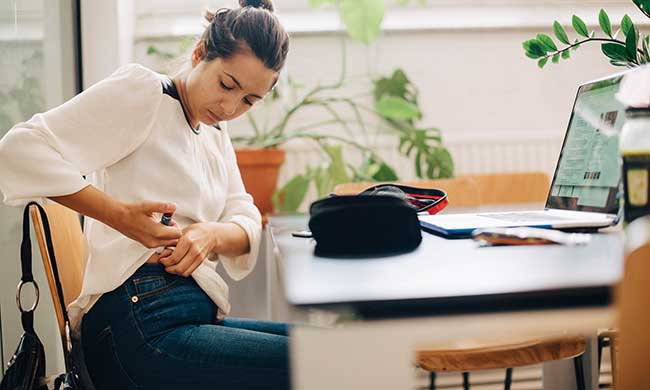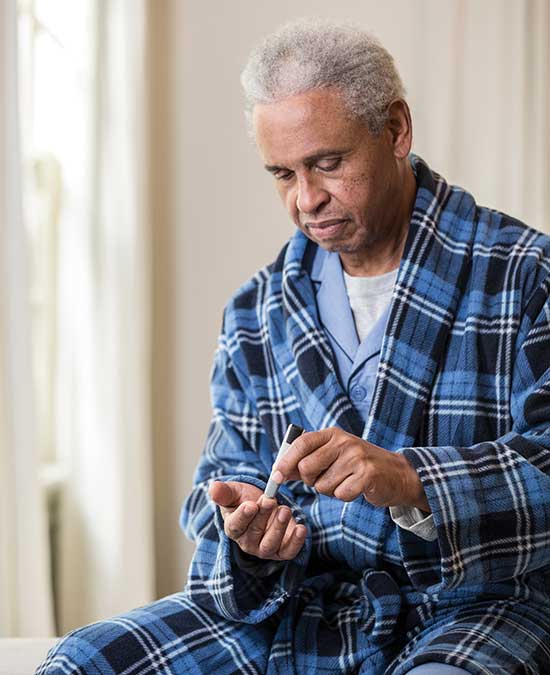HEALTHY LIVING
Understanding medical sharps; safe disposal options

(Family Features) If you’re among the millions of people in the United States who suffer from a chronic illness, you may use “sharps” to manage your medical condition at home or on the go. For example, many people with diabetes self-inject at least two insulin shots every day, and conditions including allergies, arthritis, cancer, infertility, migraines and psoriasis, among others, may also require the use of a sharp to administer medication.
A medical term for devices with sharp points or edges that can puncture or cut skin, sharps may be used at home, at work and while traveling to manage medical conditions. Examples of sharps include:

- Needles – fine, slender, hollow pieces of metal used to inject medication under the skin
- Syringes – devices to which needles are attached in order to inject medication into or withdraw fluid from the body
- Lancets, also called “fingersticks” – instruments with a short, two-edged blade used to get drops of blood for testing
- Auto injectors, including epinephrine pens – syringes pre-filled with fluid medication designed to be self-injected into the body
- Infusion sets – tubing system with a needle used to deliver drugs to the body
- Connection needles – needles that connect to a tube used to transfer fluids in and out of the body
However, disposing of those medical sharps safely may be a concern. In fact, in interviews conducted by SafeNeedleDisposal.org with sharps users, people who use needles and lancets to manage their medical conditions believe it is their responsibility to dispose of sharps safely, but lack clear, factual information on how to do so. Existing information does not always personalize disposal guidelines for people in every state or locality.
“SafeNeedleDisposal.org helps people in the United States make sense of safe sharps disposal options nearest to their home, work or wherever is convenient,” said Larry Ellingson, vice president of the National Diabetes Volunteer Leadership Council. “This resource is much needed for people who regularly use needles to manage health conditions like diabetes and want to do the right thing with their used sharps.”
According to the U.S. Food and Drug Administration, sharps not disposed of properly may cause injury. Consider these three steps for safe and proper sharps disposal:
1. Place used sharps in an FDA-cleared sharps disposal container or a strong plastic container such as an empty laundry detergent or bleach bottle.
2. Seal the container with duct tape and label it “do not recycle.”
3. For most sharps users, place the sealed container in the household trash, never the recycling. A resource like SafeNeedleDisposal.org can be used to look up local disposal guidelines by ZIP code. For states that do not allow household disposal, the website provides ZIP code-specific information on convenient drop-off locations that will accept used sharps.
For more information on safe disposal of sharps, visit SafeNeedleDisposal.org.
Photos courtesy of Getty Images
SOURCE:
NeedyMeds
HEALTHY LIVING
Safe summer fun in the sun

(Family Features) Summer is the season of sun-kissed memories – backyard barbecues, sandy beaches, bike rides and late-night stargazing. However, the warmer months bring unique safety challenges that can catch active families off guard if they’re not prepared.
From sunburns to scraped knees and dehydration to bug bites, summer’s surprises don’t have to slow you down. With a few simple precautions and the right tools on hand – like reliable first-aid essentials – you can make safety second nature and keep your focus where it belongs: on making the most of every sunny moment.
Here are a few smart, easy tips from the experts at CURAD to help your family stay protected from the sun, heat, water hazards and the inevitable bumps and bruises from outdoor play.
Shield Your Skin from Harmful Rays
The summer sun can be harsh, making it important to take steps to prevent sunburn, even if it’s partly cloudy or overcast. If you plan to be outside for more than 15 minutes, apply a broad-spectrum sunscreen with an SPF of at least 30 before heading outdoors. Remember to reapply to all exposed skin – including overlooked spots like your ears, neck and tops of feet – every two hours, or more often if you’re swimming or sweating.
Wearing protective clothing, such as wide-brimmed hats, sunglasses and light, long-sleeved shirts, can also help shield you from harmful UV rays. When possible, seek shade during peak sun hours, typically 10 a.m.-4 p.m., to minimize direct exposure.
Be Prepared for Summer Scrapes
Accidents can happen anytime, especially during active summer days. Having a well-stocked first-aid kit, including bandages, antiseptic wipes and ointments, can help you quickly address minor cuts, scrapes and blisters.
It’s important to have the right bandages on hand for every situation. Bandages made with breathable and lightweight fabric and a four-sided seal are perfect for those hot summer days. While bandages infused with natural ingredients like soothing aloe vera, vitamin E and baking soda offer a fresh approach to healing.
Proven to aid in faster healing, hydrocolloid bandages, like those infused with aloe vera from the CURAD Naturals line, offer waterproof protection that helps cushion and seal out dirt and germs for multiple days. By sealing in moisture, hydrocolloid bandages help promote the optimal healing environment.
Keep the Fluids Flowing in the Heat
During the summer months, the heat can quickly lead to dehydration, which can cause dizziness, headaches and even heat stroke. Drink plenty of water throughout the day, even if you don’t feel thirsty, to stay hydrated. Aim for at least 8-10 glasses of water (8 ounces each) each day, or more if you’re going to be spending an extended amount of time outdoors or engaging in physical activities like hiking, biking or playing sports.
Keeping a refillable water bottle with you can make it easier to stay hydrated on the go and replenish the water your body loses through sweat. In addition to water, consuming hydrating foods like watermelon, strawberries, cantaloupe, cucumbers and bell peppers can help maintain your fluid levels and regulate your body’s temperature. Also avoid excessive consumption of caffeinated or alcoholic beverages, which can contribute to dehydration.
Keep Pesky Insects at Bay
Summer evenings are perfect for outdoor activities, but they can also attract mosquitoes, ticks and other pests. Protect yourself and your family by applying insect repellent on top of your sunscreen to all exposed skin and loose-fitting clothing. Reapply as needed, according to the instructions on the package.
Repellant fans, candles, torches and bracelets may be good alternatives to spray or roll-on insect repellants. Wearing long sleeves and pants, especially in wooded or grassy areas, can also help prevent bug bites. Remember to check for ticks after spending time outdoors and, if found, promptly remove them by using clean tweezers and pulling straight upward. Avoid twisting, squeezing or burning ticks, which can lead to the release of saliva or cause the head to break off.
Have Fun in the Water, Safely
Summer is the perfect time to hit the pool, beach or lake, but remember to prioritize safety while enjoying the water. Always swim in designated areas and never swim alone. If supervising children, ensure they are within an arm’s reach and wearing properly fitting flotation devices.
Avoid alcohol when swimming or supervising swimmers, as it can impair your judgment and reaction times, and be aware of your surroundings, including weather conditions and water currents. Enrolling kids in swimming lessons can also contribute to a safer experience in the water.
Visit Curad.com for more resources to help you safely enjoy your summer adventures.

Building Your Summer Scrape Kit
A summer first-aid scrape kit can be a lifesaver for those inevitable bumps, bruises and blisters. Keep your family’s kit in a waterproof case and in an easily accessible place, such as your car, pool bag or home first-aid cabinet. Make sure to keep it stocked with essentials for cuts, scrapes, burns, blisters and beyond, such as:
- Antiseptic wipes for cleaning wounds
- Antibiotic or antimicrobial ointment to help prevent buildup of bacteria
- Bandages like CURAD Naturals Hydrocolloids with Aloe Vera to treat minor cuts, scrapes and blisters
- Non-latex gloves to protect hands from dirt and germs
- Hydrocortisone cream for bug bites and rashes
- Sunscreen to help prevent sunburn
- Aloe vera gel for sunburn relief
- Water bottles to stay hydrated
- Ear drops for preventing or treating swimmer’s ear
- Insect repellent to help prevent bug bites
- Tweezers for removing splinters and pests
- Pain-relieving medications such as ibuprofen or acetaminophen
- Ice packs to help slow inflammation and reduce pain
- Thermometer tocheck temperature
- Other medications for allergies, nausea, congestion and more
SOURCE:
HEALTHY LIVING
Pediatric growth hormone deficiency (PGHD) 101

What parents should know about pediatric growth hormone deficiency
(Family Features) Pediatric growth hormone deficiency (GHD) is a relatively rare condition, affecting an estimated 1 in 4,000-10,000 children. Despite its rarity, GHD can significantly impact a child’s growth and development, which can potentially lead to short stature, delayed puberty, decreased muscle mass, delay in bone maturation and psychosocial implications.
With early diagnosis and appropriate treatment, children with GHD can achieve improved growth outcomes and lead healthy lives. Increasing understanding of GHD treatment options and closing knowledge gaps can make a difference in the patient and caregiver journey.
What is PGHD?
Growth hormone plays a critical role in helping young bodies grow and develop, including improving muscle metabolism, growing bones and breaking down fats.
PGHD occurs when a child’s pituitary gland is unable to produce enough growth hormone which results in noticeable changes on the growth chart.
Children with PGHD may look younger than their peers of the same age and gender, and puberty may be delayed or absent. Muscle development, metabolism and bone strength may also be impacted by insufficient or inadequate levels of growth hormone.
While growth hormone stimulates height increase during development, its role in the body extends beyond childhood. Even after growth plates close, growth hormone plays a vital role for cardiovascular health and for maintaining normal body structure and metabolism. Research also indicates osteoporosis as a long-term implication of GHD, highlighting its importance in overall health and well-being.
What are the Symptoms?
PGHD may be apparent during infancy, or it may not be revealed until later in childhood. Children with PGHD tend to have typical body proportions but noticeably slow growth. Other symptoms may include an immature or significantly younger look than other children of the same age, chubby body build, slow hair and nail growth, teeth that come in late and episodes of low blood sugar.
Children who have experienced a brain injury, brain tumor or radiation treatment involving the head are at higher risk for PGHD. Genetic factors can also increase risk.
How are Children Diagnosed?
Generally, doctors attempt to rule out other causes of slow growth, which may include genetic short stature, poor nutrition – which may be the result of an underlying condition such as celiac disease – and other genetic conditions, such as a hypothyroidism or Turner syndrome.
X-rays to evaluate bone age and imaging to identify the location of the pituitary gland can support the diagnosis. Another common screening option is a growth hormone stimulation test, in which medications are administered to trigger the release of growth hormone and blood is drawn frequently to monitor the body’s response.
What Treatment Options are Available?
Once a diagnosis is confirmed, children with PGHD often work closely with an endocrinologist to develop a treatment plan that includes growth hormone replacement therapy and closely monitor future growth. Dosing is based on weight and requires ongoing monitoring for adjustments. Traditionally, treatment was through daily injections, but more recently, weekly injections became available.
Children with PGHD who begin treatment early in life are more likely to reach adult height consistent with their family’s stature.
Learn more about PGHD at GHDinKids.com.

From Playdate to PGHD
During a visit to a friend’s house, Erin Swieter noticed her 18-month-old daughter, Ingrid, was about a head shorter than her peer who was six weeks younger. Upon learning her friend’s daughter was only in the 10th percentile for height, Swieter realized Ingrid must be even smaller.
While she was hitting her developmental milestones, she was still wearing 9-to-12-month clothes and had a baby-like appearance. Swieter took her concerns to Ingrid’s pediatrician; her growth charts were monitored closely for the next several months.
Following a move to a new city, the Swieters found a new pediatric endocrinologist, who was instrumental in diagnosing Ingrid. The endocrinologist reviewed previous labs and monitored Ingrid’s growth carefully, eventually diagnosing her with PGHD after a failed growth hormone stimulation test.
“Receiving Ingrid’s diagnosis was a relief, as it confirmed our suspicions and gave us a clear path forward,” Swieter said.
After learning about daily injections, the Swieters were hesitant about proceeding. The Swieters discussed their worries with Ingrid’s pediatric endocrinologist, who recommended weekly injections as a viable option due to Ingrid’s age and the duration of treatment she would likely need.
“We had heard from other parents about the challenges of daily medications, which could pose a problem during travel, day trips or sleepovers at Grandma’s house,” Swieter said. “The weekly injection eliminates the need for a daily treatment routine.”
Navigating the insurance approval process proved challenging, but once Swieter provided evidence of two failed growth hormone stimulation tests, the weekly injections were approved.
“Insurance and pharmacy challenges can be frustrating, but patience and persistence are key,” Swieter said. “Educate yourself about your insurance, treatment options, and medical literature to be a strong advocate for your child.”
Ingrid has embraced opportunities to share her journey with her condition through a school project, proudly engaging her classmates in conversations about her experience. At the same time, she is making strides physically, continuing to grow and thrive.
Photos courtesy of Shutterstock (mom measuring daughter and mom and son talking to doctor)
Real patient and caregiver photo courtesy of Erin Swieter (mom and daughter hiking)
SOURCE:
HEALTHY LIVING
Understanding the hidden dangers of LDL (Bad) Cholesterol

(Family Features) These days, wellness information is practically everywhere you turn. Do this; don’t do that. Eat more of this; eat less of that. This is good for you; that is bad.
It can be hard to cut through all the noise, but the reality is, when it comes to something as serious as your heart health and LDL cholesterol – the “bad” cholesterol – ignoring it can be downright dangerous for your health.
According to the American Heart Association, about every 40 seconds, someone in the United States has a heart attack, and strokes occur at about the same frequency.
High LDL cholesterol, often called “bad” cholesterol, significantly increases your risk of heart disease.
A poll conducted by The Harris Poll for the American Heart Association revealed 75% of heart attack and stroke survivors reported having high cholesterol. Yet nearly half (47%) of heart attack and stroke survivors are unaware of their LDL cholesterol number. This lack of awareness shows more knowledge is needed to help survivors proactively manage their health.
In fact, knowledge is key to reducing your risk of heart disease. Understanding the impact of LDL cholesterol and knowing your LDL number can help you make informed decisions.
Cholesterol: The Good and The Bad
Cholesterol is a waxy, fat-like substance your body needs to build cells and produce hormones. However, not all cholesterol is created equal:
- LDL (low-density lipoprotein) Cholesterol: This is the “bad” cholesterol. When too much LDL cholesterol circulates in the blood, it can build up in the inner walls of the arteries that feed the heart and brain, forming plaque that can narrow and eventually block these arteries, leading to heart attack or stroke.
- HDL (high-density lipoprotein) Cholesterol: Known as the “good” cholesterol, HDL helps remove the “bad” cholesterol from the arteries, protecting against heart attack and stroke.
A Silent Threat
Many people think high cholesterol has obvious signs, but that’s not always the case. In fact, about half of U.S. adults and 42% of heart attack and stroke survivors mistakenly believe high cholesterol has clear symptoms. However, high LDL cholesterol typically doesn’t show any signs, which is why it’s known as a silent threat to your heart.
People who have had a heart attack or stroke are at higher risk of future cardiovascular problems, which is why it’s important to monitor your cholesterol regularly to help prevent future events.
It’s also important to know high LDL cholesterol can be genetic, meaning someone who eats a healthy diet and exercises regularly can still have high cholesterol. Additionally, the risk of high LDL cholesterol increases with age.
That’s why the American Heart Association’s “Lower Your LDL Cholesterol Now” initiative, nationally sponsored by Amgen, emphasizes the importance of regular cholesterol checks regardless of your weight, diet and physical activity levels. Knowing your LDL cholesterol number – and understanding the target levels based on your health history – gives you the opportunity to manage your health proactively. This enables you to make informed decisions to prevent future heart issues.
Know Your Number
You can reduce your risk of a heart attack or stroke by knowing and addressing your LDL cholesterol number.
Working closely with your doctor allows you to actively manage high LDL cholesterol – often a key risk factor you can help control – and together, you can develop a personalized treatment plan. Ask your doctor or health care provider for a cholesterol test to know your LDL number. Understanding your cholesterol number is the first step toward managing it effectively. If necessary, appropriate management of your LDL cholesterol can help reduce your risk of a heart attack or stroke.
Your doctor may also talk with you about your personal and family medical history; previous heart-related medical events such as a heart attack or stroke; lifestyle habits such as tobacco use, obesity, unhealthy living or aging; racial and ethnic backgrounds; and reproductive health.
Lower is Better
When it comes to your cholesterol, guidelines from the American Heart Association and the American College of Cardiology recommend “lower is better” to reduce your risk. Studies show that an LDL number or below 100 mg/dL is ideal for healthy adults.
If you have a history of heart attack or stroke and are already on a cholesterol-lowering medication, your doctor may aim for your LDL to be 70 mg/dL or lower.
Talk to your doctor about the right treatment plan for you. Positive lifestyle habits, such as exercising and eating a healthy diet, may also help.
However, if you’ve had a heart attack or stroke before, lifestyle changes alone may not be enough to lower your risk of another event. Your doctor may recommend cholesterol-lowering medications to protect your heart health.
Learn more about LDL (bad) cholesterol by visiting heart.org/LDL.
SOURCE:
-

 NEWS3 years ago
NEWS3 years ago2 hurt, 1 jailed after shooting incident north of Nocona
-

 NEWS2 years ago
NEWS2 years agoSuspect indicted, jailed in Tia Hutson murder
-

 NEWS2 years ago
NEWS2 years agoSO investigating possible murder/suicide
-

 NEWS3 years ago
NEWS3 years agoWreck takes the life of BHS teen, 16
-

 NEWS2 years ago
NEWS2 years agoMurder unsolved – 1 year later Tia Hutson’s family angry, frustrated with no arrest
-

 NEWS2 years ago
NEWS2 years agoSheriff’s office called out to infant’s death
-

 NEWS2 years ago
NEWS2 years agoBowie Police face three-hour standoff after possible domestic fight
-

 NEWS3 years ago
NEWS3 years agoDriver stopped by a man running into the street, robbed at knifepoint






